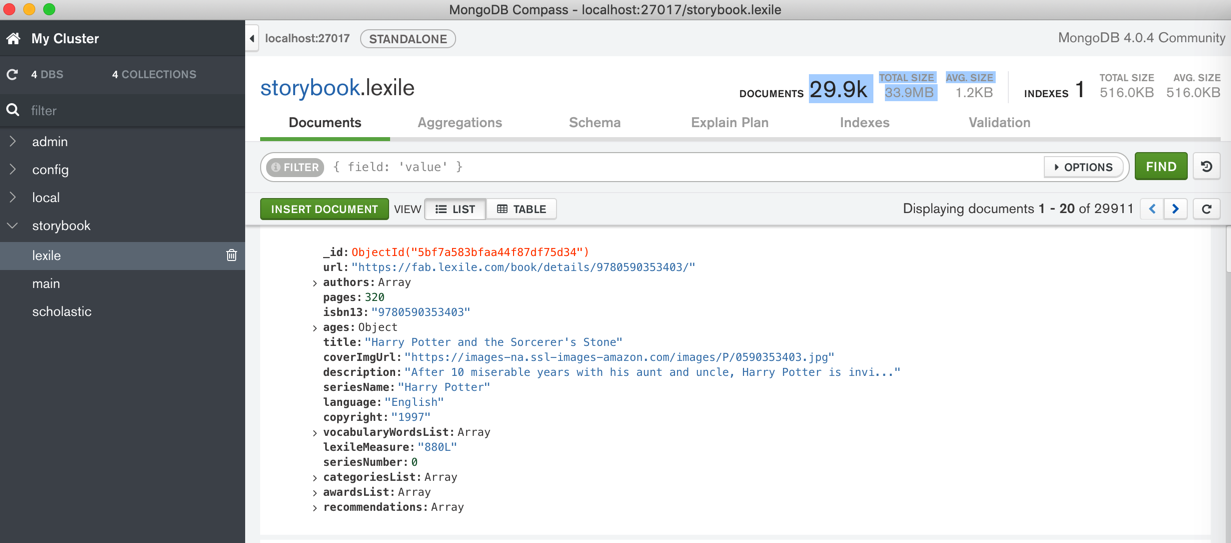
In both cases if the keys specified exist on a document they are used, otherwise they aren't. You can just ask MongoDB for any set of keys (i.e the projection part of the query) or query on any set of keys. Though this is the case, most applications do maintain a schema for their collections and as said by Chris this is enforced by your application.Īs such you wouldn't have to worry about first fetching the available keys to make a query. So there can't really be a description of a collection, like the description of a table in the relational databases. MongoDB being schema-less allows a single collection to have a documents with different fields. So if you're looking for the schema in MongoDB, look towards your application for answers and not the database.Įssentially I am saying the exactly same thing as Shain :)ĪFAIK, there isn't a way and it is logical for it to be so. We don't have to worry about keeping the database tables/columns in-sync with the class structure. With MongoDB, if we had to change a particular model, we simply add, remove, or modify the fields in the class itself and it works right off the bat. In the former example, the fields are right there in front of our eyes. In the latter version with MySQL, the fields are being pulled from the database directly. This operation sorts the documents in the users collection, in descending order according by the age field and then in ascending order according to the value in. Now after switching to MySQL, our classes look like this, class Consumer < ActiveRecord::Baseĭon't get fooled by the brevity of the classes. For instance, in our Rails application, these are two of the models we have in Mongo, class Consumer As long as you know that admins are not secretly logging into Mongo and making changes, and all access to the database is controller through some wrapper, the only place you should look at for the schema is your model classes. The database will shove in whatever it is given. Of course, there is a schema involved when dealing with schema-less databases like MongoDB, but the schema is dictated by the application, not the database. But having implemented the same model on both MongoDB and MySQL, I can clearly see the difference now. Unfortunately, we have switched back to MySQL after working with MongoDB because of my company's current infrastructure issues. Basic syntax of MongoDB sort() db.collection_name.find().sort()”.This is my day 30 or something like that of playing around with MongoDB. Here the positive one represents the ascending order, while the negative one represents the descending order. The sorting order in MongoDB is defined by either a one (1) or a minus (-1). These building blocks are fields to be sorted and the sort order.


The sort() method consists of two basic building blocks. In MongoDB, sorting is done by the sort() method. The main advantage of sorting is that it increases the readability and uniformity of the data, which helps the users grasp the meaning of the data set more effectively. You can carry out sorting operations on various data types such as:

Use the right-hand menu to navigate.) What is database sorting?ĭatabase sorting presents data in an ascending or descending order with relation to the data in a specified field. (This article is part of our MongoDB Guide. With the use of aggregation expressions and syntax, you can project new fields or project existing fields with new values. Not only that, sorted data will be used by developers to write more complex algorithms. Starting in MongoDB 4.4, db.collection.find () projection can accept aggregation expressions and syntax. Using the sort() method will increase the readability of a query, which leads to a better understanding of a given dataset.
Mongodb compass sort desc how to#
In this article, I’ll show you how to use the MongoDB sort() method in various scenarios, including how to use it alongside other methods to sort a given data set.


 0 kommentar(er)
0 kommentar(er)
